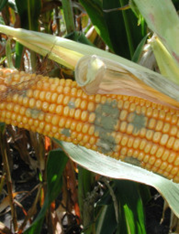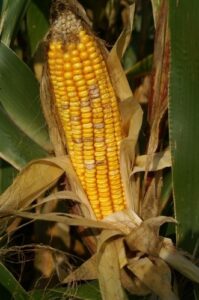Note: Insect trap data are unavailable from much of southern New Jersey this past week due to staff shortages. No maps will appear in this edition. Maps will resume later in September as conditions permit. Interpretations from available data will continue in the absence of maps.
Sweet Corn
European corn borer (ECB) moth catches are nearly non-existent now. At this time, no feeding has been detected.
 Aspergillus mold species often show up after drought conditions, posing a significant risk of aflatoxins in the corn crop if present. Aspergillus molds are carcinogenic to people and cause losses in livestock and poultry. Combine operators and elevator operators should take precautions against inhaling fungal spores. Signs of Aspergillus ear rot include evidence of powdery olive-green mold on the ear tip or on kernels in the ear.
Aspergillus mold species often show up after drought conditions, posing a significant risk of aflatoxins in the corn crop if present. Aspergillus molds are carcinogenic to people and cause losses in livestock and poultry. Combine operators and elevator operators should take precautions against inhaling fungal spores. Signs of Aspergillus ear rot include evidence of powdery olive-green mold on the ear tip or on kernels in the ear.

